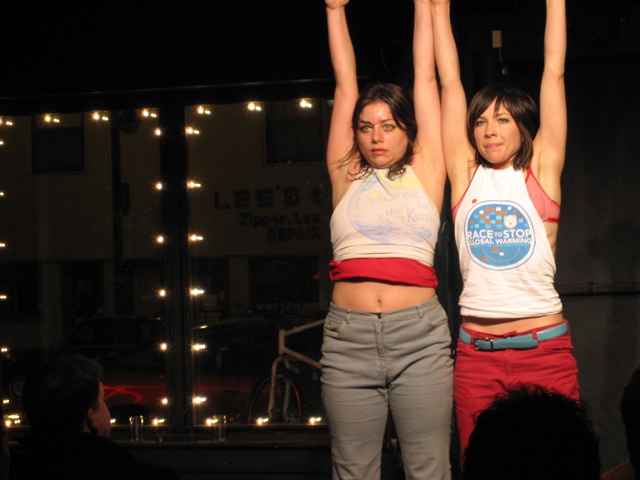The Last Saturday: Free Radicals at the Bowl
Lightsey Darst sums up the whole Saturday Is the New Monday Series, late of the Bryant Lake Bowl, and advocates for more of this kind of thing.

The last performance in the Saturday is the New Monday Series was “Free Radicals,” curated by Susan Scalf
at the Bryant-Lake Bowl Theater.
First, I will miss the oddly named “Saturday is the New Monday” series. Every weekend in February there was new dance to see at the Bryant-Lake Bowl, fresh imagination popping off (sometimes literally) the small stage. Watching this series, I wondered whether this couldn’t be the norm here in Minneapolis rather than a one-off production. Minneapolis abounds in small dance groups and independent choreographers for whom a full-length production is a strain (or simply an impossibility); they need more opportunities (like Kinetic Kitchen and 9 x 22) to show their work without having to carry the full burden of production. Plenty of great dancers perform in Minneapolis, but many of them perform too seldom to perfect their roles or their stage presence; they also need more performance practice. Impractical? Hardly: during the “Saturday is the New Monday” series, I went to only one show (a Sunday matinee) for which the house wasn’t packed—which suggests to me that these shows might be training a dance audience as well.
This last performance, “Free Radicals,” curated by Susan Scalf, began with Krista Langberg and Jane Shockley bouncing, panting, and then dancing in some bulky jackets. Nothing much happened, but Langberg and Shockley move with a strange conviction, as if they are being governed by heavenly bodies; watching them, I had the sense of invisible arcs and unseen lines coming numinously to being. The final phrase of their dance (a swooping sequence repeated over and over) had the power good ballet commands, the mysticism of strange rules well followed.
Dylan Skybrook’s solo for Megan Flood, “Sweet Megan Vicious,” played with Flood’s rather wholesome local image and proved that she can play a confused, angry, edgy character (however, she does not swear convincingly). The piece, which is still in progress, plays with gaze and exhibition, casting a projection of Flood wandering peacefully naked through a wild landscape against the live, black corset and slit skirt-clad Flood, who eventually strips down to her knickers in a moment of confusion and irresistible urge. It’s an interesting area of exploration, and Skybrook works in some clever, almost childishly seductive gestures, but the piece loses energy toward the end.
The centerpiece of “Free Radicals” is Emily Johnson and Susan Scalf’s funny but hard-edged presentation on location, responsibility, and work. I say “presentation” because someone is almost always talking to the audience in this dance-theater piece—which is not to say that Johnson and Scalf aren’t creative in the accompaniments to their speech. Besides jumping on each other, lying on the stage, and otherwise dancing, they open the shuttered windows at the back of the Bryant Lake Bowl stage (and eventually the back door as well) and use the environment as part of the performance space. “Minneapolis is a great town,” Scalf and Johnson say together, water glasses in hand, and then splatter the water on the glass, on the image of Minneapolis—after which they frantically try to control the spill, tracing droplets with their fingers. Another time, Johnson tells us, “Beyond that window is a super America,” while pointing in the direction of the SuperAmerica gas station just down the street.
However clever the mode of presentation, the content must still be considered; and here Scalf and Johnson fall short of their own invention. “We cannot escape humanity,” they say, tumbling into the street to encounter some hapless pedestrians. This statement is either obvious (we are human) or very much open to debate (is dancing in the street interaction or just invasion?). Scalf and Johnson explain who they are in terms of their homelands and the solid old-fashioned jobs of their families (“Susan is from the Cumberland mountain area of Tennessee, and she is the daughter of a librarian and the granddaughter of an electrician”—apologies to Scalf: I’ve forgotten exactly what her forebears did). They do this to elevate honest work, so that they can later talk about “doing our job” (i.e., dancing), but the move has unintended consequences. After all, I find myself thinking, I’m the daughter of a bureaucrat. That’s right; but he does, I have to say, eat organic potato chips. Which is better, an organic potato chip eating bureaucrat or a Hormel corned beef hash in a can eating farmer? I’m being flip, but Scalf and Johnson opened the door. Artists can talk about going to work like bakers and candlestickmakers, but in reality we’re a lot more like priests (or bureaucrats?): what we produce has an intangible value. Scalf and Johnson, in their urge to give the audience a loaf of bread, become didactic, and in so doing they miss the heart of their own performance—because a deep and unplumbed grief, a silent death, hangs at the center of this work, animating its cutting humor and its quirky desperation.
If I quibble with what Scalf and Johnson put forward, still I enjoyed the piece. “Free Radicals” as a whole is massively enjoyable, punctuated with fun, smart bits like
Megan Mayer and Jaime Carrera’s strange little duet about animal coupling (they stamp like horses and sniff each other like cats). Dylan Skybrook, the host, throws cupcakes into the audience; Steve Naïve (no real name is given) lipsynchs 80s British rock with an odd mix of nerdiness and sexy assurance. Finally, there’s Sarah Gordon’s marvelous winter striptease, to which description cannot do justice. Let’s just say I wish I’d brought a stack of ones.